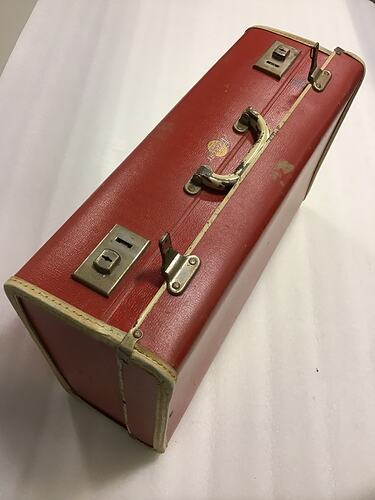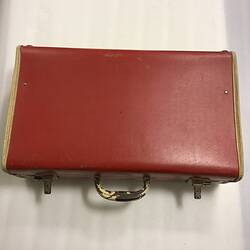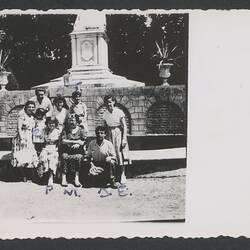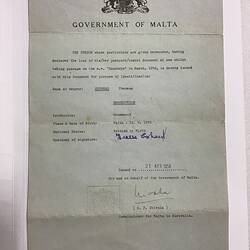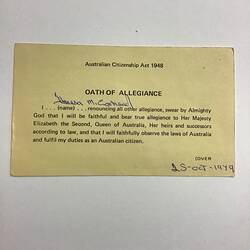Summary
Small red suitcase given by the International Red Cross to the Coxhead family (Teresa Coxhead) when they arrived in Australia from Malta. The suitcase (and other suitcases issued to the family) had contained clothing and personal items needed by the family who had lost all their possessions after their ship, the SS Skaubryn, caught fire en route on 31 March 1958.
The migrating family consisted of: Louise Coxhead, her daughters Teresa, Pauline (later Farren) and Emily with her husband Tony Calleja and their two children Joseph and Carmen. The suitcase originally contained clothes for them to wear (none of which have survived) and the Museum also holds three photographs (MM 167303 and MM 167304) showing the three women wearing the clothes they had been issued, along with the identity certificate (HT62841) issued by the Commissioner for Malta in Australia declaring the loss of passports and travel documents due to the Skaubryn's sinking; and an Oath of Allegiance card (HT 62930) issued to Teresa Coxhead for her citizenship ceremony 25 October 1979.
Physical Description
Red suitcase with hard exterior, cream trim and cream lined fabric interior, handle and two press button locks.
Significance
This collection enables the representing of a significant naval event in the history of post World War II migration to Australia through a very personal first-hand account. It also documents the role of the International Red Cross in supporting passengers who lost all their belongings in the disaster. It also relates to the desire by the Maltese government after World War II for emigration due to over-population. In 1951 they concluded that 'the optimum population was no more than 250,000 and that considerable emigration was necessary - at least 5% of the population per year - to reduce the total population from 310,000 to 250,000 and to cancel out the natural increase of 10,000 per year.'
The Skaubryn was a Norwegian passenger liner which caught fire on 31 March 1958 in the Indian Ocean during its voyage to Australia. There were 1080 passengers onboard [note, there are differing figures recorded], mostly German and Maltese migrants, and 208 crew. It was the only vessel lost at sea during the post WWII era of migration to Australia.
The passengers and crew all abandoned ship into lifeboats and were rescued by the ship City of Sydney. Many passengers had no lifejackets and an elderly German passenger died after suffering a heart attack. Some passengers were subsequently flown from Aden to Darwin while most of the rest of the passengers travelled to Australia on the SS Orsova.
More Information
-
Collecting Areas
-
Issued To
-
Issued To
-
Issued To
-
Related Person (See Comments)
Anne-Louise Farren, Australia, 1958
One of the recipinets of the suitcase contents and object donor. -
Inscriptions
Brand label: 'AIRLIGHT'
-
Classification
-
Category
-
Discipline
-
Type of item
-
Object Dimensions
560 (Width), 320 (Depth), 180 (Height)
-
Keywords
Shipboard Travel, Shipping Lines, Immigrant Shipping, Shipwrecks, Maltese Immigration, Luggage
